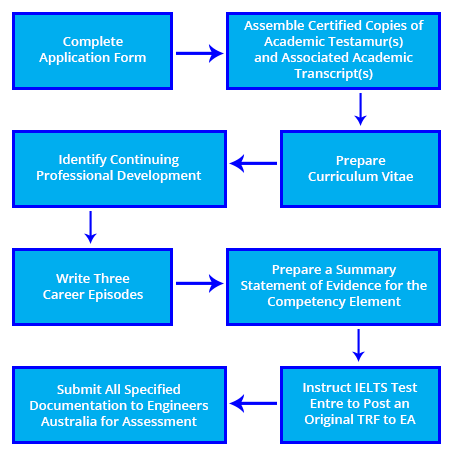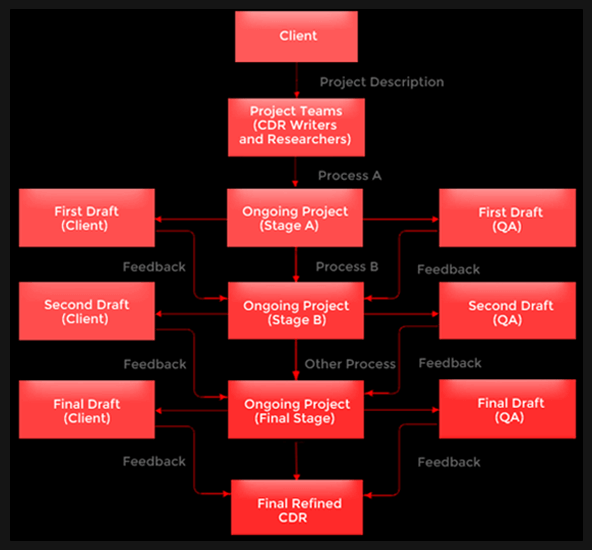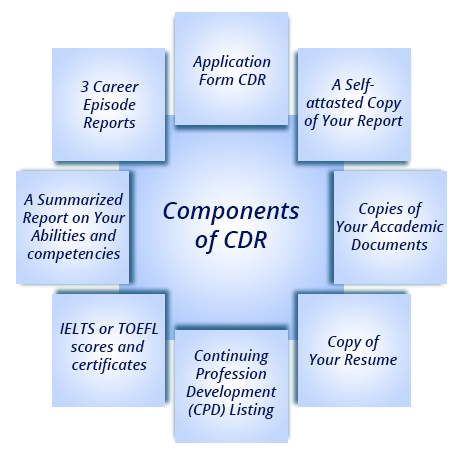
The set of competences and commitments require for the registration of an individual as an an Engineering Technician (EngTech), Incorporated Engineer (IEng) or Chartered Engineer (CEng) are postulated by the UK Standard for Professional Engineering Competence (UK-SPEC).The demonstration of the required competences and commitments are done by making use of examples that are included in it.
There are five generic areas of competence and commitment for all registrants, which broadly cover -
Each area constitutes of a threshold generic standard and are set out for each title that is involved. A matrix comparing all the needs for the three titles mentioned above is provided by the UK-SPEC. This helps in assisting in the application for a given title by a potential registrant, their advisers and professional review interviewers.
The framework of UK- SPEC is a collaborative effort of members who are the representative of the entire breadth of the profession or that constitute the entire ‘Universe of Engineering’. This includes professionals from industry to academia and a wide array of disciplines and specialisations.
The demonstration of competence and commitment is essential for the professional registration with the Engineering Council. The competitive requirements and commitments that are required in an individual for registering as an Engineering Technician (EngTech), Incorporated Engineer (IEng) or Chartered Engineer (CEng) are described in the UK Standard for Professional Engineering Competence (UK-SPEC. The instances where the requirements needed to achieve for enabling individuals and employers a better understanding of their current position and the position of the staff in fulfilling the registration requirements. A list of the qualifications that are required for proper knowledge and understanding in this regards are also listed. However, other ways of highlighting the achievement of these standards are also available.
The measures mandatory for the achievement of professional registration are also explained in this document along with the various obligations undertaken that ensures acting in public interest and integrity. A membership at a licensed professional engineering institution is required to be placed on the registrants to achieve the professional registration and ensure the fulfilling of the set obligations.
The requirements for the three titles are provided in a matrix along with a glossary of terms which is included on Page 36 in the form of an Annex.
The engineering competence and commitment is valuably presented in the form of registration to either of the categories. Nevertheless, the development from EngTech to IEng and from IEng to CEng can also be facilitated on grounds of experience and other professional and knowledge development as they move on with their career. The key criteria for registration include the testimonials of competence and commitments. Moreover, there is an extra need for acquiring additional knowledge and training for the registration of an individual in a different title or job role.
The current and future safeguarding of the society is largely vested upon the systems and processes that are underpinned by professional registration. The registration sets the standards for the individuals which are looked upon by the employers, government and society of the UK. Moreover, employers outside the UK can also look forward to these registrations as the benchmark for hiring technicians and professional engineers. This depicts the fact that these professionals possess the required knowledge, skills and commitments that can help them to cater to the engineering requirements of today and of future trends in the industry as well.
Engineers and technicians who are not qualified are set apart from individual professionals by means of registrations. The knowledge, understanding and skills and competencies are testified and established by these registrations. An individual’s commitment towards ensuring the maintenance of professional standards and a continual process of development are presented in the registrations in particular.
The assurance regarding the fact that employees having registrations have had their competence independently tested and have verified credentials as well are provided to the employers by these registrations. Moreover, the employers are also certain about the fact that employees are committed to the cause of Continuing Professional Development (CPD). The recognition of the peers can be easily gained by professional having registrations as they have already met the standards of knowledge and experience as set by the UK standards, which is recognized globally. There is a need for a professional to undertake a continuous development cycle and are exposed to new developments in the industries. This is ensured by the maintenance of membership at a professional institution and is benefitted from the knowledge of the developments in this field. The determination of the obligations is governed by a code, which is set to govern the professional code of conduct.
Non-UK residents or people residing outside the UK also apply for the Engineering Council registration. A worldwide recognition of Engineering Technicians, Incorporated Engineers and Chartered Engineers are provided by the registrations as is mentioned in the UK-SPEC. There are cases where a particular work cannot be availed without professional registration. Tendering for work and applying for jobs outside of the UK can be facilitated better by a professional registration.
An involvement in a series of multilateral mutual recognition agreements with national engineering bodies of other countries have been facilitated by UK-SPEC. The national body also reflects on the requirements of global engineering and actively participates in these agreements. Washington Accord is one of the major agreements since 1989 that has grown beyond six English-speaking countries was founded by the organization. The Sydney and Dublin Accords, the International Engineering Technologists Agreement and the International Professional Engineers Agreement have been developed by the organization in association with multiple partners. The governance of body is jointly done by the APEC Engineers Agreement and the International Engineering Alliance. The strengthening of the voice of engineers at the European level is facilitated by the Engineering Council in association with the European Federation of National Engineering Associations (FEANI).
The commitment of the engineers and technicians contributing towards other countries is maintained and looked after by the engineering council. These engineers and technicians were registered in the UK and this includes foreign candidates who were registered outside of the UK but are eligible under the standards set by the UK governing body.
The maintenance of necessary standards in the discharge of competence and commitment at work is an essential aspect for being eligible for professional registration in the UK.
The Engineering Council has licensed a few professional engineering institutions which are the places from where interested candidates can apply for registrations. Advice regarding the overall process of review and the required timeline for the review are also provided by the institutions. These can be extremely beneficial for the applicants. A list of institutions can be found at: www.engc.org.uk/peis
A professional review or the assessment process is conducted to test the applicants. The requirements of the chosen institution are taken into consideration while applying for the initiation of the overall process. There is a need for providing a formal documented testimonial regarding the claims of qualification, experience and training. Moreover, the institution will also provide a detailed description of the format of the review. A relation between the required competences and commitments and the details being submitted by the applicant is to be portrayed during submission.
Annex A has been drafted, which contains a matrix that consists of the requirements for the three titles. This is provided to assist potential registrants, their advisers and professional review assessors in deciding the most appropriate category of registration.
An application for registration can be initiated by the Members of a Professional Affiliate (see glossary) who have an agreement with any licensed institution through the institution itself. For a current list of Professional Affiliates please see: www.engc.org.uk/pas
The following of effective and set standards while completing or taking up a task is called competence. An amalgamation of the appropriate levels of knowledge, understanding, skills and a professional attitude is mandatory for ensuring the development of competence. Initial professional development comprising of formal and informal learning and training and experience are necessary for the development of greater competence. A formal structure is lacking in this case and these elements are not necessarily separate or arranged in a sequence.
Competence and commitment standards for registration as an Engineering Technician, Incorporated Engineer or Chartered Engineer, and include some examples of the kind of evidence that would help to demonstrate these. The list of examples is not intended to be exhaustive. There may be other examples and local equivalents.
There is a set of five generic areas concerning competence commitment for all registrants which broadly covers the following:
The educational qualification that is required formally for the demonstration of the necessary knowledge and understanding concerning each category of registration and underpinning competence is also provided. An increased level of workplace knowledge can be an effective means for demonstrating the required knowledge and understanding. Apart from this, there are other alternatives as well, for ensuring better process of registration.
A personal and professional commitment towards the society is facilitated by registered engineers and technicians. This encompasses commitment towards their profession and environment. The maintenance and enhancement of the reputation of the profession is of utmost importance, for which they are required to adopt a set of values and principles. Specific evidence is required in the areas of:
The standard E5 in the revision of the document of UK-SPEC highlights the need to exercise responsibilities in an ethical way. The members of the profession are required to aspire by a set of standards that have been put forward in the Statement of Ethical Principles developed by the Engineering Council and the Royal Academy of Engineering (www.engc.org.uk/professional-ethics). These standards are to be imbibed by the members in their working habits and relationships. All these values are applicable under all circumstances and scenarios where there is a need for engineers and technicians to exercise their judgements.
A variety of sources are present where the information regarding the aforementioned standards is present. Page 33 of this document consists of a generic framework that inspires the code of conduct of each institution.
Guidance on risk and sustainability and a CPD code has been published by the Engineering Council on Page 9 of the documents for the registrants to follow.
Continuing Professional Development (CPD)is an essential aspect that the Engineering Technicians, Incorporated Engineers and Chartered Engineers Should take care of and facilitate throughout their professional career. In particular they should:
The solutions to a practical engineering problem are engendered following a set of proven techniques and procedures followed by Engineering Technicians.
A safe system of work is required to be applied by Engineering Technicians and they should be able to demonstrate:

Do you see yourself working in an engineering role where on a daily basis it is your skills and know-how that ensure success?
If the answer in both cases is yes, then you will also want to see your professionalism recognised – an ambition you can achieve by gaining the title Incorporated Engineer (IEng).
Incorporated Engineers maintain and manage applications of current and developing technology, and may undertake engineering design, development, manufacture, construction and operation. Incorporated Engineers are variously engaged in technical and commercial management and possess effective interpersonal skills.
Eligibility
IEng status is attainable through demonstration of the required professional competence and commitment. These are set out in the professional standard, UK-SPEC, and are typically developed through education and work experience. There are different ways in which you can meet the requirements, on which your institution will be able to advise or please see our website for further details.
Not yet ready for IEng?
If you have not yet built up the required competences for IEng you may wish to consider the Engineering Technician (EngTech) qualification as a stepping stone to IEng.
How to become professionally registered?
We provide Premium writing services for UK-SPEC competence and commitment requirements for IEng registration.
Engineering design, development, manufacture, construction and operation might be undertaken by the Incorporated Engineers who also maintain and manage applications of current and developing technology.
Incorporated Engineers are able to demonstrate:
Continuing Professional Development (CPD)is an essential aspect that the Engineering Technicians, Incorporated Engineers and Chartered Engineers Should take care of and facilitate throughout their professional career. In particular they should:
The solutions to a practical engineering problem are engendered following a set of proven techniques and procedures followed by Engineering Technicians.
A safe system of work is required to be applied by Engineering Technicians and they should be able to demonstrate:
Chartered Engineers develop solutions to engineering problems using new or existing technologies, through innovation, creativity and change and/or they may have technical accountability for complex systems with significant levels of risk.
Chartered Engineers are able to demonstrate:





